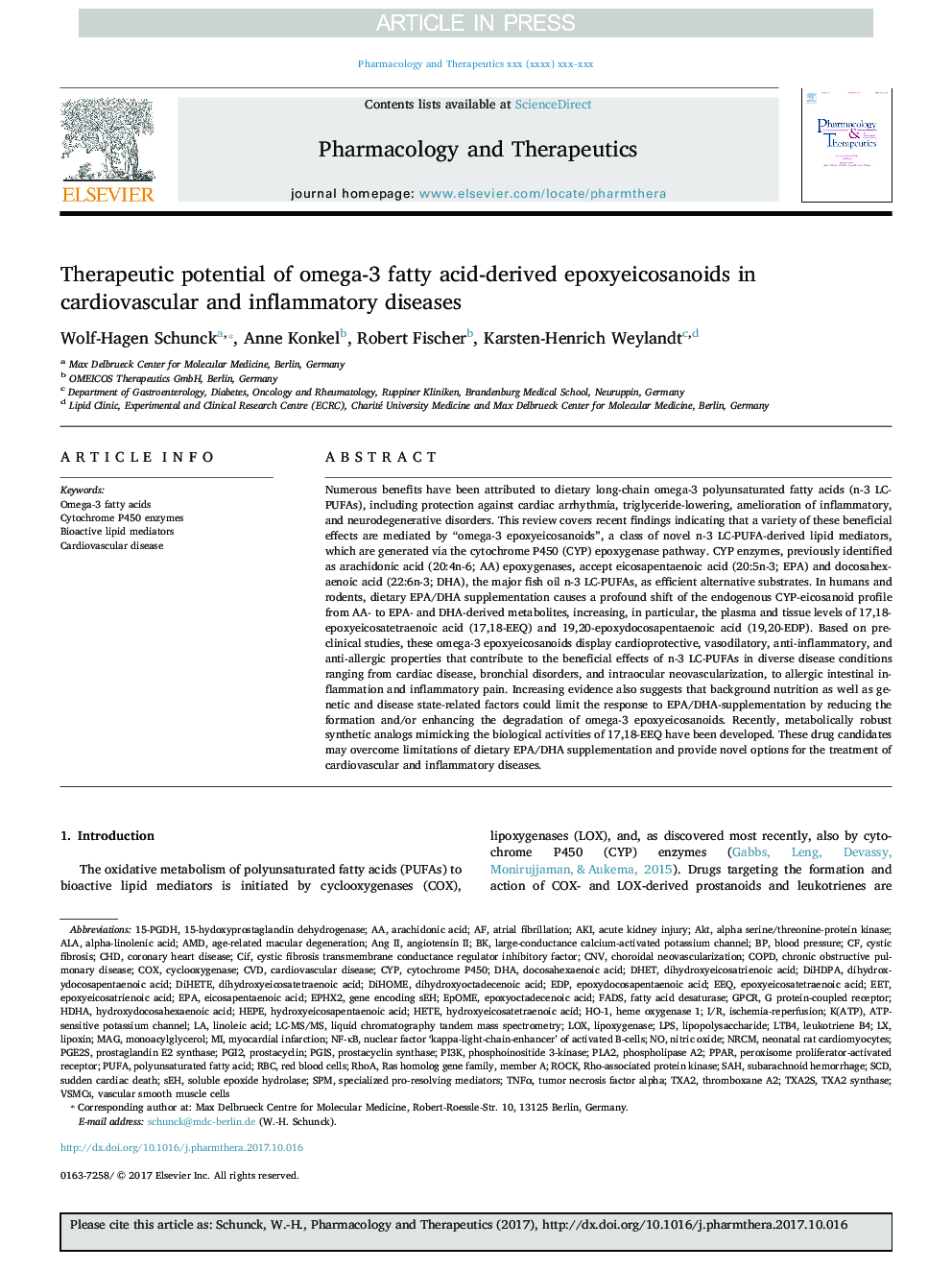| Article ID | Journal | Published Year | Pages | File Type |
|---|---|---|---|---|
| 8536912 | Pharmacology & Therapeutics | 2018 | 28 Pages |
Abstract
Numerous benefits have been attributed to dietary long-chain omega-3 polyunsaturated fatty acids (n-3 LC-PUFAs), including protection against cardiac arrhythmia, triglyceride-lowering, amelioration of inflammatory, and neurodegenerative disorders. This review covers recent findings indicating that a variety of these beneficial effects are mediated by “omega-3 epoxyeicosanoids”, a class of novel n-3 LC-PUFA-derived lipid mediators, which are generated via the cytochrome P450 (CYP) epoxygenase pathway. CYP enzymes, previously identified as arachidonic acid (20:4n-6; AA) epoxygenases, accept eicosapentaenoic acid (20:5n-3; EPA) and docosahexaenoic acid (22:6n-3; DHA), the major fish oil n-3 LC-PUFAs, as efficient alternative substrates. In humans and rodents, dietary EPA/DHA supplementation causes a profound shift of the endogenous CYP-eicosanoid profile from AA- to EPA- and DHA-derived metabolites, increasing, in particular, the plasma and tissue levels of 17,18-epoxyeicosatetraenoic acid (17,18-EEQ) and 19,20-epoxydocosapentaenoic acid (19,20-EDP). Based on preclinical studies, these omega-3 epoxyeicosanoids display cardioprotective, vasodilatory, anti-inflammatory, and anti-allergic properties that contribute to the beneficial effects of n-3 LC-PUFAs in diverse disease conditions ranging from cardiac disease, bronchial disorders, and intraocular neovascularization, to allergic intestinal inflammation and inflammatory pain. Increasing evidence also suggests that background nutrition as well as genetic and disease state-related factors could limit the response to EPA/DHA-supplementation by reducing the formation and/or enhancing the degradation of omega-3 epoxyeicosanoids. Recently, metabolically robust synthetic analogs mimicking the biological activities of 17,18-EEQ have been developed. These drug candidates may overcome limitations of dietary EPA/DHA supplementation and provide novel options for the treatment of cardiovascular and inflammatory diseases.
Keywords
EPANF-κBPI3KCNVTNFαLPSCOXAKICyPSCDHO-1RhoAAMDALARBCMAGmonoacylglycerolPPARSPMGPCREDPSAHFADS15-PGDHCHDLTB4PLA2TxA2CIFVSMCsPGI2PGISEPHX2DiHETEEEQHEPENRCMepoxyoctadecenoic acidnuclear factor ‘kappa-light-chain-enhancer’ of activated B-cellsdihydroxydocosapentaenoic acidHDHAprostaglandin E2 synthaseRed blood cellsDHETI/RLC-MS/MSChoroidal neovascularizationras homolog gene family, member AsEHacute kidney injurycyclooxygenasephospholipase A2cytochrome P450 enzymesMyocardial infarctionAngiotensin IIAktArachidonic acidalpha-linolenic acidepoxyeicosatrienoic acidepoxydocosapentaenoic acidepoxyeicosatetraenoic acidEicosapentaenoic aciddocosahexaenoic aciddihydroxyeicosatrienoic aciddihydroxyeicosatetraenoic aciddihydroxyoctadecenoic acidFatty acid desaturaseLinoleic acidhydroxyeicosatetraenoic acidhydroxyeicosapentaenoic acidhydroxydocosahexaenoic acidOmega-3 fatty acidsPolyunsaturated fatty acidPUFAEpOMELOXischemia-reperfusioncoronary heart diseasecardiovascular diseaseCOPDChronic obstructive pulmonary diseaseThromboxane A2tumor necrosis factor alphaEETSubarachnoid hemorrhageAng IIDHADiHOMECVDVascular smooth muscle cellsage-related macular degenerationProstacyclin synthaseCytochrome P450phosphoinositide 3-kinaseBlood pressureCystic fibrosisAtrial fibrillationLeukotriene B4lipoxygenaselipopolysaccharidelipoxinSudden cardiac deathNitric oxideHETEheme oxygenase 1Soluble epoxide hydrolaseSpecialized pro-resolving mediatorsRho-associated protein kinaseprostacyclinneonatal rat cardiomyocytesATP-sensitive potassium channelLarge-conductance calcium-activated potassium channelliquid chromatography tandem mass spectrometryperoxisome proliferator-activated receptorG protein-coupled receptorRock
Related Topics
Health Sciences
Pharmacology, Toxicology and Pharmaceutical Science
Pharmacology
Authors
Wolf-Hagen Schunck, Anne Konkel, Robert Fischer, Karsten-Henrich Weylandt,
